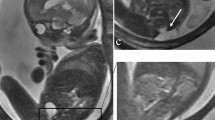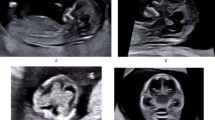Abstract
Introduction
We hypothesized that magnetic resonance imaging (MRI) can assess fetuses with sonographically (ultrasonography (US))-suspected neural tube defects (NTD) that might influence their diagnoses and management decision.
Methods
Institutional review board approval and informed consents were obtained to perform MRI for 19 fetuses referred with US-suspected NTD. Prenatal imaging findings were correlated with management decision, postnatal clinical, postnatal imaging, and pathology.
Results
Prenatal MRI correctly ruled out US diagnosis of cephalocele in a fetus. In the other 18 fetuses, MRI detected detailed topography and contents of NTD sacs in five, added central nervous system (CNS) abnormalities that were not apparent on US in three, and confirmed non-CNS findings in three fetuses. MRI changed diagnosis of 3/19 fetuses (15.8%), caused minor change in diagnosis of 5/19 (26.3%), and did not influence US diagnosis of 11/19 fetuses (57.9%). MRI findings changed/modified management decision in 21% of the fetuses.
Conclusion
Fetal MRI is an important adjunct to US in assessing NTD. It can identify topography and contents of sacs, add CNS and non-CNS findings, and influence management decision.







Similar content being viewed by others
References
De Marco P, Merello E, Mascelli S et al (2006) Current perspectives on the genetic causes of neural tube defects. Neurogenetics 7(4):201–221
McGahan JP, Pilu G, Nyberg D (2003) Neural tube defects and the spine. In: Nyberg D, McGahan J, Pretorius D, Pilu G (eds) Diagnostic imaging of fetal anomalies. Lippincott Williams & Wilkins, Philadelphia, pp 291–334
Birnbacher R, Messerschmidt AM, Pollak AP (2002) Diagnosis and prevention of neural tube defects. Curr Opin Urol 12(6):461–464
Shurtleff DB, Lemire R (1995) Epidemiology, etiologic factors, and prenatal diagnosis of open spinal dysraphism. Neurosurg Clin N Am 6(2):183–193
Steinbok P, Irvine B, Cochrane DD et al (1992) Long-term outcome and complications of children born with meningomyelocele. Childs Nerv Syst 8(2):92–96
Hubbard AM, Simon EM (2002) Fetal imaging. Magn Reson Imaging Clin N Am 10:389–408
Simon EM, Goldstein RB, Coakley FV et al (2000) Fast MR imaging of fetal CNS anomalies in utero. AJNR Am J Neuroradiol 21:1688–1698
Turgut F, Turgut M, Onur E et al (2001) In utero MR imaging and management of foetal hydrocephalus and NTDs in the third trimester. J Neurosurg Sci 45(3):189–192
Glenn OA, Barkovich AJ (2006) Magnetic resonance imaging of the fetal brain and spine: an increasingly important tool in prenatal diagnosis, part 2. AJNR Am J Neuroradiol 27:1807–1814
Griffiths PD, Widjaja E, Paley MN et al (2006) Imaging the fetal spine using in utero MR: diagnostic accuracy and impact on management. Pediatr Radiol 36(9):927–933
von Koch CS, Glenn OA, Goldstein RB et al (2005) Fetal magnetic resonance imaging enhances detection of spinal cord anomalies in patients with sonographically detected bony anomalies of the spine. J Ultrasound Med 24:781–789
Rossi A, Cama A, Piatelli G et al (2004) Spinal dysraphism: MR imaging rationale. J Neuroradiol 31(1):3–24
Kolble N, Huisman TA, Stallmach T et al (2001) Prenatal diagnosis of a fetus with lumbar myelocystocele. Ultrasound Obstet Gynecol 18:536–539
Mangels KJ, Tulipan N, Tsao LY et al (2000) Fetal MRI in the evaluation of intrauterine myelomeningocele. Pediatr Neurosurg 32(3):124–131
Haacke EM, Wielopolski PA, Tkach JA et al (1990) Steady-state free precession imaging in the presence of motion: application for improved visualization of the cerebrospinal fluid. Radiology 175(2):545–552
Chung HW, Chen CY, Zimmerman RA, Lee KW, Lee CC, Chin SC (2000) T2-Weighted fast MR imaging with true FISP versus HASTE: comparative efficacy in the evaluation of normal fetal brain maturation. AJR Am J Roentgenol 175(5):1375–1380
Guibaud L (2004) Practical approach to prenatal posterior fossa abnormalities using MRI. Pediatr Radiol 34:700–711
Coniglio SJ, Anderson SM, Ferguson JE (1996) Functional motor outcome in children with myelomeningocele: correlation with anatomic level on prenatal ultrasound. Dev Med Child Neurol 38:675–680
Aaronson OS, Hernanz-Schulman M, Bruner JP (2003) Myelomeningocele: prenatal evaluation—comparison between transabdominal US and MR imaging. Radiology 227:839–843
Kollias SS, Goldstein RB, Cogen PH, Filly RA (1992) Prenatally detected myelomeningoceles: onographic accuracy in estimation of the spinal level. Radiology 185:109–112
Korenromp MJ, van Gool JD, Bruinese HW, Kriek R (1986) Early fetal leg movements in myelomeningocele. Lancet 1(8486):917–918
Correia-Pinto J, Reis J, Hutchins G, Baptista MJ, Estevao-Costa J, Flake AW, Leite-Moreira AF (2002) In utero meconium exposure increases spinal cord necrosis in a rat model of myelomeningocele. J Pediatr Surg 37:488–492
Sutton LN (2008) Fetal surgery for neural tube defects. Best Pract Res Clin Obstet Gynaecol 22(1):175–188
Rintoul NE, Sutton LN, Hubbard AM, Cohen B, Melchionni J, Pasquariello PS, Adzick NS (2003) A new look at myelomenigoceles: functional level, vertebral level, shunting, and the implications for fetal intervention. Pediatrics 109:409–413
Fichter MA, Dornseifer U, Henke J, Schneider KTM, Kovacs L, Biemer E, Bruner J, Adzick NS, Harrison MR, Papadopulos NA (2008) Fetal spina bifida repair—current trends and prospects of intrauterine neurosurgery. Fetal Diagn Ther 23:271–286
Leung EC, Sgouros S, Williams S, Johnson K (2002) Spinal lipoma misinterpreted as a meningomyelocele on antenatal MRI scan in a baby girl. Childs Nerv Syst 18(6–7):361–363
Adzick NS, Walsh DS (2003) Myelomeningoclele: prenatal diagnosis, pathophysiology and management. Semin Pediatr Surg 12(3):168–174
Bouchard S, Davey MG, Rintoul NE, Walsh DS, Rorke LB, Adzick NS (2003) Correction of hindbrain herniation and anatomy of the vermis after in utero repair of myelomeningocele in sheep. J Pediatr Surg 38(3):451–458
D’Addario V, Pinto V, Di Cagno L et al (2005) The midsagittal view of the fetal brain: a useful landmark in recognizing the cause of fetal cerebral ventriculomegaly. J Perinat Med 33:423–427
Pilu G, Segata M, Ghi T et al (2006) Diagnosis of midline anomalies of the fetal brain with the three-dimensional median view. Ultrasound Obstet Gynecol 27:522–529
Chen CP (2007) Prenatal diagnosis of iniencephaly. Taiwan J Obstet Gynecol 46(3):199–208
Pungavkar SA, Sainani N, Karnik AS et al (2007) Antenatal diagnosis of iniencephaly: sonographic and MR correlation: a case report. Korean J Radiol 8(4):351–355
Simon EM, Pollock AN (2004) Prenatal and postnatal imaging of spinal dysraphism. Semin Roentgenol 39(2):182–196
Coakley FV, Hricak H, Filly RA et al (1999) Complex fetal disorders: effect of MR imaging on management-preliminary clinical experience. Radiology 213:691–696
Acknowledgment
The authors thank Miss Amal Mahmoud, the MRI technician.
Conflict of interest statement
We declare that we have no conflict of interest.
Author information
Authors and Affiliations
Corresponding author
Rights and permissions
About this article
Cite this article
Saleem, S.N., Said, AH., Abdel-Raouf, M. et al. Fetal MRI in the evaluation of fetuses referred for sonographically suspected neural tube defects (NTDs): impact on diagnosis and management decision. Neuroradiology 51, 761–772 (2009). https://doi.org/10.1007/s00234-009-0549-0
Received:
Accepted:
Published:
Issue Date:
DOI: https://doi.org/10.1007/s00234-009-0549-0




